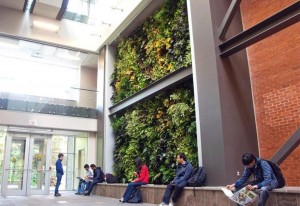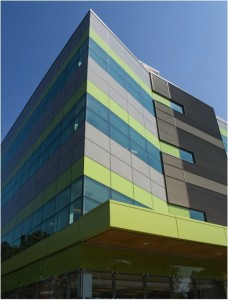
The living wall at the Environment 3 building in Waterloo, Ontario. Clicking the photo will take the reader to a video about the building’s features. Photo: Doors Open Waterloo Region.
A sustainable building for environmental studies just opened at the University of Waterloo in Waterloo, Ontario.
The building is called Environment 3 because of additions built on top of two prior incarnations. It features a constructed wetland to cleanse wastewater, a system to track utility use and a “living wall” to filter volatile compounds from the air.
It opened up Sept. 15 as a part of Doors Open, an annual heritage site and architectural tour in Canadian cities.
The “bio wall” is a two-story vertical garden attached to a ventilation system. The ductwork at the back of the wall sucks air through the vegetation and redistributes it back into the building’s atrium.

The exterior of Environment 3. Photo: University of Waterloo Faculty of Environment.
The building is designed to use 46 percent less energy than a standard building of its size and generates 60,000 kilowatt-hours of electricity from solar panels each year, said Paul Parker, professor of geography and environmental management at the university.
“This means that the annual energy bill is cut in half,” he said.
The features certify the building as meeting the Leadership in Energy and Environmental Design standard, developed by the U.S. Green Building Council, a non-profit promoting sustainable architecture.
